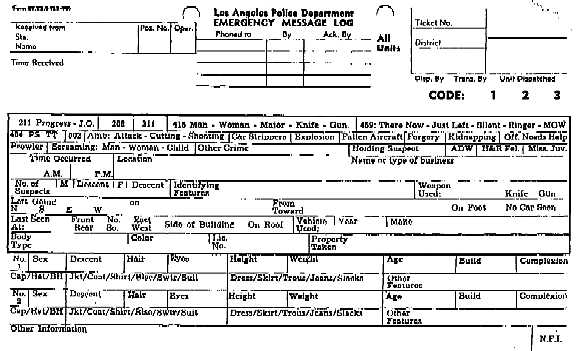
Mid 1970s LAPD RADIO MESSAGE LOG - "White - Routine Call"

The boxes across the top are for: Call Back No.; Pos (Complaint Board Position #), Rec By (Operator # who took the phone call); "Phoned To/By/Ack By" when necessary for us to make a phone call re this incident, e.g. tow service, ambulance, more info from caller, etc., who called, what # and whom they spoke to. Rptg Dist: Reporting District of the call (each geographic division has 20-50 "RD's"); Disp Dispatcher (police officer in those days) who assigned the unit; R.T.O.: (Civilian) Radiotelephone Operator who broadcast the call. Unit Dispatched: Unit(s) Dispatched.
The 5, 8 & 14 numbers refer to Harbor, West L.A. and Venice (now "Pacific") Divisions, respectively. Having been annexed to the city in the early part of the 20th century, they have a number of duplicative street names...e.g., there might be a 602 7th Street downtown, another in San Pedro (Harbor Div) and another in Venice. The 5, 8 or 14 would be circled to alert the dispatcher that the call was in one of these "outlying" divisions.
Code 1, 2 or 3: "Code 1" was not a priority level for a call, but was used to get a unit's attention after you had given them a call but they hadn't acknowledged it. Officers sometimes felt that it implied they weren't paying attention to the radio, so many RTO's would first ask, "7A29, did you receive?" or "7A29, come in" and give out the call when they answered. "Code 1" came to be used mostly when the call was relatively urgent and you needed to get somebody going. (But never when he had ticked you off earlier in the shift and you wanted to get him back. Nah, RTOs would never do anything like that.)
Code 2 meant "urgent" call, but no siren or red lights; Code 3 was "emergency," use red lights and siren. These codes were generally at the dispatcher or call-taker's discretion, but that was frequently subject to discussion. Over the years, use of "Code 3" has waxed and waned; in the early 70's, not much went code 3 except "Officer Needs Help" calls, "211 (robbery)" alarms at banks. 211's or shootings-in-progress or other life-threatening calls would go Code 3 at the complaint-board officer's discretion, if the call appeared to be valid and critical enough. Plain old 459s (burglaries) and "just occurred" shootings, cuttings, robberies invariably went code 2. Traffic accident calls were NEVER code 3 except the occasional "person trapped in a burning vehicle" or some such. The rationale, I suppose, was that the ambulance, if any, would be going Code 3, and the officers were just going along for the paperwork.
Below the address lines, the various codes and messages were very succinctly and, for the most part, logically arranged, so the operator simply had to circle all the appropriate items. The ticket was time-stamped in various places to indicate time received, time dispatched, time completed, and a few other times for special messages. And each call was sequentially number-stamped by the RTO at the time it was dispatched.
L.A.P.D. "EMERGENCY MESSAGE LOG" - Early 1970s

(Unfortunately, this thirty-year-old ticket with black ink on blue paper won't reproduce very well; if I can obtain a better copy I'll post it here)
These blue tickets were used in dispatching more serious crime-in-progress calls ("hot shots"), as well as recording "crime broadcast" information provided by the unit at the scene. Again, the most common words and codes are preprinted, needing only to be circled, and the format provided for a fairly uniform sequence of information for all crime broadcasts. Of course, the officers didn't have these tickets in the field, so they would give the RTO their information in whatever order they happened to have jotted it down or remembered it. After receiving and broadcasting a few hundred of these, most RTOs could keep up with the fastest talking, most excited officer and get all the information down the first time.
I'll be happy to try to answer any email questions about these tickets or broadcasting procedures, and will try to get the rest of the tickets posted as soon as possible, especially the most commonly used form, the pink "Officer Initiated Message Log."